Composting in winter is fun, and it’s easier than you might think. In this post, I will show you all you need to know about winter composting, including the benefits, maintaining the proper balance of browns and greens, and avoiding common problems.
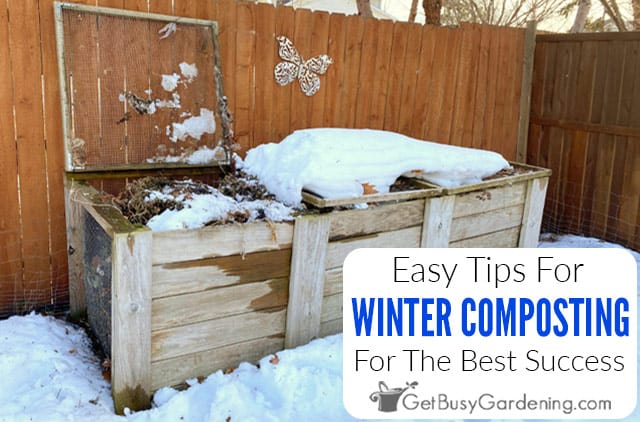
Winter composting can seem like a huge challenge. Especially if you live in an area where it gets freezing cold.
But if you’re like me, it feels like such a waste to throw away all of those awesome kitchen scraps, rather than tossing them into your bin, tumbler, or heap.
Well guess what? You don’t have to stop composting in winter, and it’s actually easier than you might think.
In this detailed guide you’ll learn all about how to prepare your pile in the fall, the benefits of winter composting, and all you need to know to keep going, even through the coldest and snowiest months of the year.
Can You Compost Year Round?
Yes! No matter where you live, you can compost all year round. If you are in a cold climate like I am, then your compost pile will likely go dormant in winter (i.e. freeze solid).
But don’t worry, that is ok. Each time the temperature warms up, the process starts again – causing a freezing and thawing effect that will break everything down faster.
If you’re lucky enough to live in a milder climate, then you can keep your compost pile active all winter long. However, it is important to monitor the moisture level so it doesn’t get too dry or soggy.
Benefits Of Winter Composting
There are lots of benefits of composting in winter. First, you’re able to keep using all of the scraps from cooking, instead of tossing them into the trash.
You’ll also have a head start on spring! Decomposition will be much slower during the cold months, and will stop all together in frigid temperatures.
But the benefit is that all of the freezing and thawing helps to break the compost heap down much faster once the weather warms up. Giving you all of that black gold sooner than if you would have taken the coldest months off.
How To Keep Composting In Winter
If your compost bin is close to your house, then you can simply dump the scraps in, just like you would during the summer.
However, if it’s in the far back corner of your yard (like mine is!), then you might not like the idea of trudging out in the snow every time you finish cooking – yah, I don’t either.
So I put my scraps in my compost pale under the sink. Then, once that’s full, I dump it into 5-gallon buckets with tight fitting lids that I keep in my porch. It freezes out there, so they don’t get stinky.
You can put your buckets in an unheated garage, or even outside, as long as the lids are on tight (to avoid attracting rodents).
When the large buckets full, I make the trek out to the garden to dump everything into my compost bin.
Oh, and if you get a lot of snow like we do here in MN, keep a path shoveled to your compost heap to make it easier to walk out there through the winter.
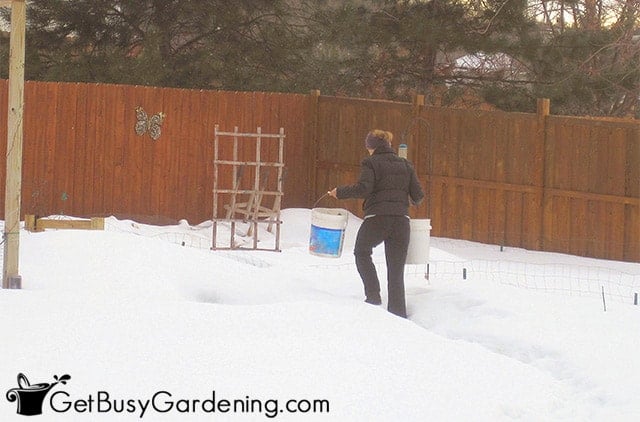
7 Winter Composting Tips & Techniques
There are several tips and tricks that I have learned over the many years I’ve been composting in winter. Here are some of the best things you can do for the best success.
1. Remove Existing Compost Before Winter Hits
To keep your bin from overflowing in winter, remove any compost that’s ready to use in the fall. This will ensure there’s plenty of room for adding all the new ingredients over the next several months.
Fall is a great time to add compost to your flower beds, or to help prepare your veggie garden for winter.
2. Pile On The Brown Matter
Regardless of the season, a healthy compost pile requires a good balance of both green materials (like kitchen food scraps) and brown materials (e.g. leaves, yard waste, grass, etc).
Since most of what you’ll likely be adding to your compost heap during the winter will be kitchen scraps, you should prepare it for that in the fall.
That means piling on the brown matter early. So, dump in all the leaves and yard waste that you can in the fall.
These items will help to insulate the compost to keep it active in the cold as long as possible. Plus, they will ensure all of the green ingredients are well balanced come spring.
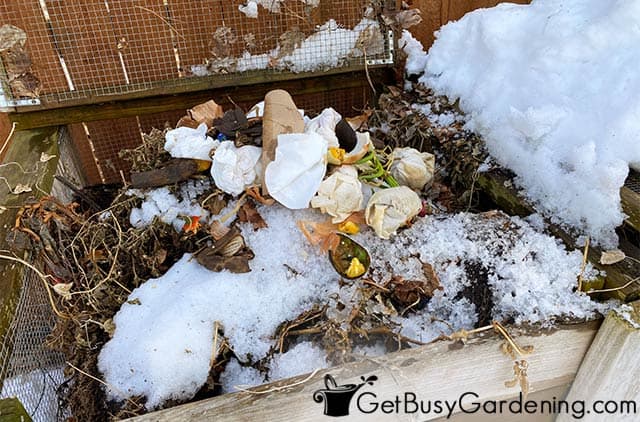
3. Keep The Compost Bin Lid Open So It Won’t Freeze
If it freezes where you live, it’s a good idea to keep the lid of your compost bin open during the winter.
Otherwise, once it’s covered by snow and ice, you may not be able to open it. Or you could risk damaging it by forcing it open.
On the other hand, if you live in a wet climate, then you may have trouble with your heap getting soaked. In that case, you can either leave the lid on, or cover it with a tarp or something similar.
If you decide to keep the lid closed, just make sure to brush it off after every snowfall, so it doesn’t freeze shut.
4. Monitor The Moisture Level
Maintaining adequate moisture isn’t a problem for gardeners who live in a freezing, snowy area like I do.
But, if your winter weather is extremely dry or wet, then you should keep an eye on the moisture level of your compost heap.
It won’t break down if it’s too dry, so you’ll need to water your pile regularly. On the flip side, a cold and soggy pile could become stinky and gross.
To fix that common winter composting problem, cover the heap with a tarp, and add more brown materials to soak up the excess water.
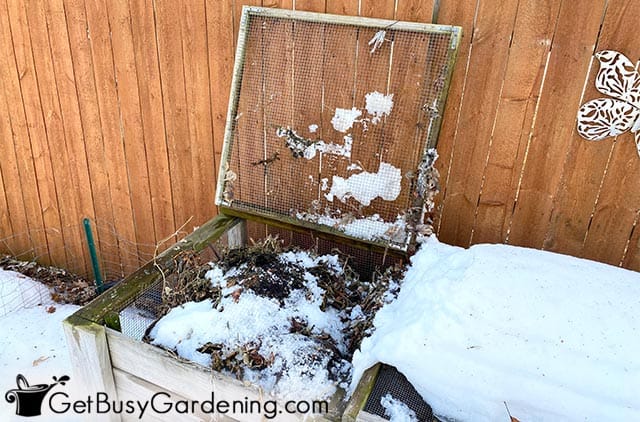
5. Add The Right Compost Ingredients In Winter
As long as you fill your bin with brown matter in the fall, then you should only add green materials to your compost heap in winter.
Otherwise, you’ll need to continue to layer the greens with browns to keep the pile in balance. Too much green matter will end up creating a sloppy, stinky mess.
6. Cover The Freshly Composted Items
After dumping the new materials into my bin, I cover everything with snow. The snow adds moisture, and also keeps the heap from looking like an eyesore.
Alternatively, you could put a bag or pile of brown matter (leaves, yard debris, etc) next to your bin through the winter. Then cover the kitchen waste with layers of browns to hide it, and also keep the proper balance.
For those of us who in extremely cold areas, you can layer the compost with cardboard or newspaper instead (since a pile of leaves will freeze solid, making it impossible to separate).
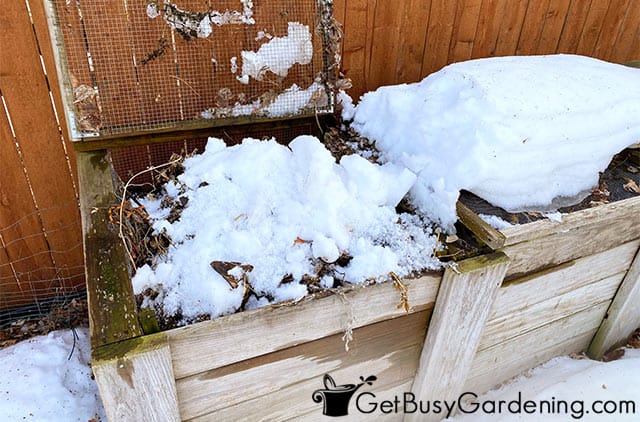
7. Don’t Try To Turn Your Compost Pile In Winter
If your compost pile, bin, or tumbler freezes solid during the winter (like mine does), then don’t try to turn it.
Your efforts will be futile, and you could wind up damaging the bin (or your back!). Besides, there’s no need to turn it anyway.
If it does warm up enough to easily mix it, then by all means you can go ahead and give it a couple of turns.
But, don’t waste your time trying to break up large clumps of frozen compost. It will break down on its own once it thaws.
Reactivating Your Winter Compost Heap
Once the compost starts to thaw in early spring, I work on turning it as much as I can to help reactivate it. Turning it regularly also helps the ingredients break down faster.
Don’t worry if there are still large frozen chunks in there, just turn what you can, and leave the rest to thaw.
At this point, you can also add more brown materials, like leaves or straw, which will also help activate the pile faster.
This will reduce the moisture level if your winter compost is really wet from all that melting snow or spring rain.
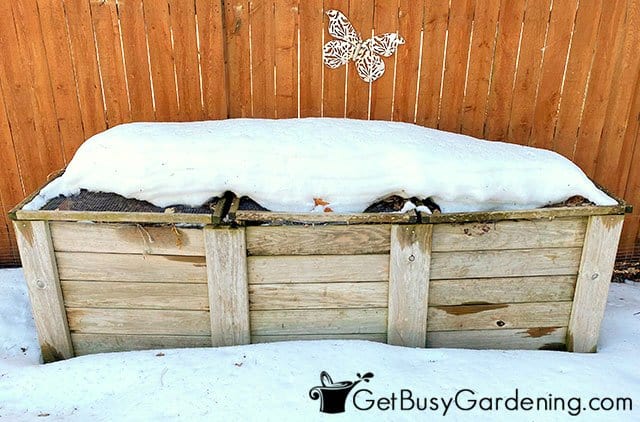
Winter Composting FAQs
Still have questions about composting in winter? Here are answers to the ones I get the asked most frequently. If you can’t find an answer here, then ask about it in the comments below.
Can you start a compost pile in the winter?
Yes, you could certainly start a compost pile during the winter. Just remember that it will take much longer to become established, and for the composting materials to start breaking down in winter -vs- summer.
How do you activate compost in the winter?
In areas with mild weather, surround your heap with straw, leaves, newspaper, cardboard, or snow to insulate it. That’s usually enough to keep a compost pile active all winter.
You could also try covering it with a lightweight, breathable fabric, like burlap, for example. This can help hold in the heat and moisture.
However, if you live somewhere frigid like I do, then your compost will eventually freeze solid and go dormant, no matter what you do. But that’s totally normal, and nothing to worry about.
Should I cover my compost pile in the winter?
It’s not necessary to cover your compost in winter. However, covering it can help keep the moisture and heat in, so it will stay active longer.
Covering it will also make it easier to protect the pile from getting saturated with water, or drying out too quickly in milder climates.
Composting in winter is fun and easy. No matter where you live, you can use your bin or heap all year long to reduce waste, and keep making all that wonderful black gold for your garden beds.
More About Garden Soil
- How To Make A No Dig Garden
- How To Build A Cheap DIY Compost Bin
- 7 Easy DIY Potting Soil Recipes To Mix Your Own
- Lasagna Gardening 101: How To Make A Lasagna Garden
Share your winter composting tips or advice in the comments section below.
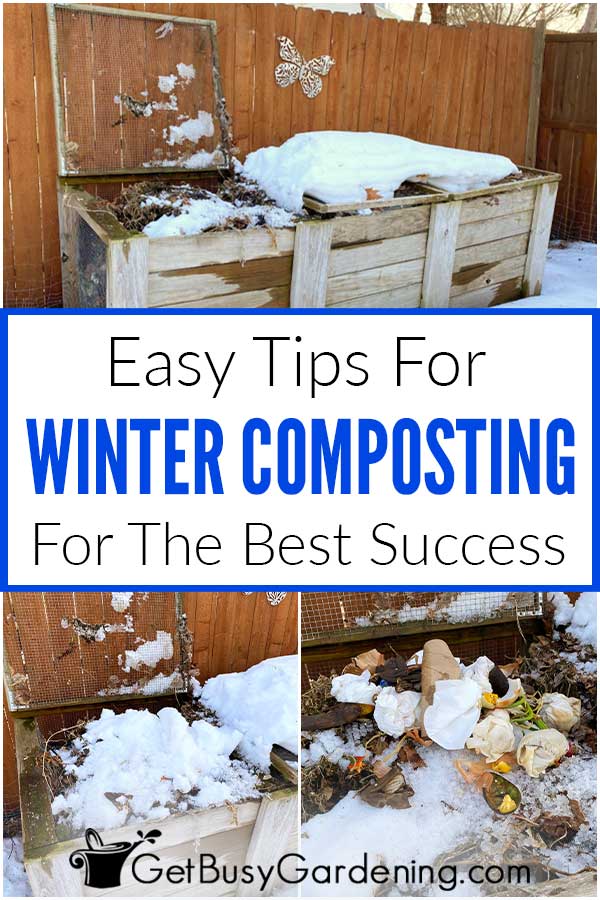
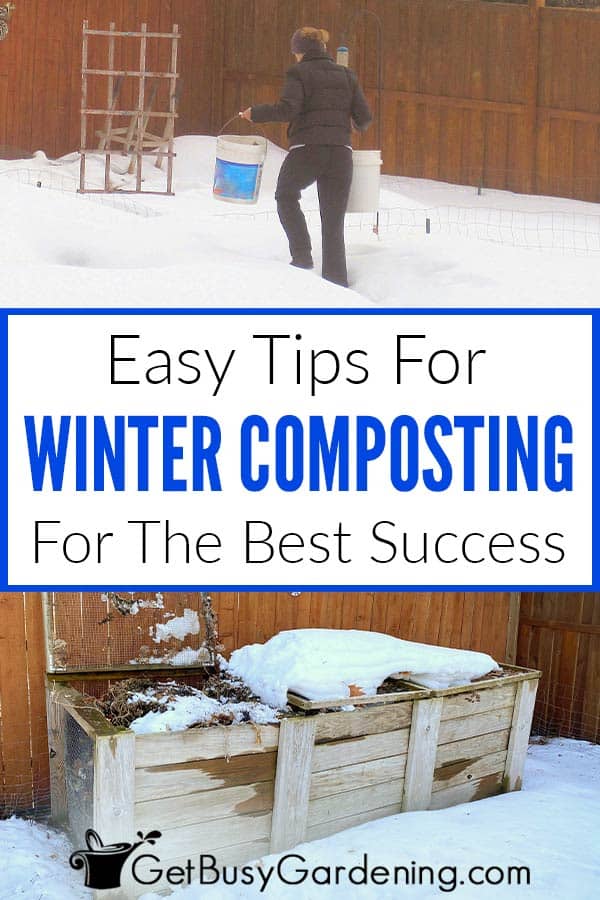
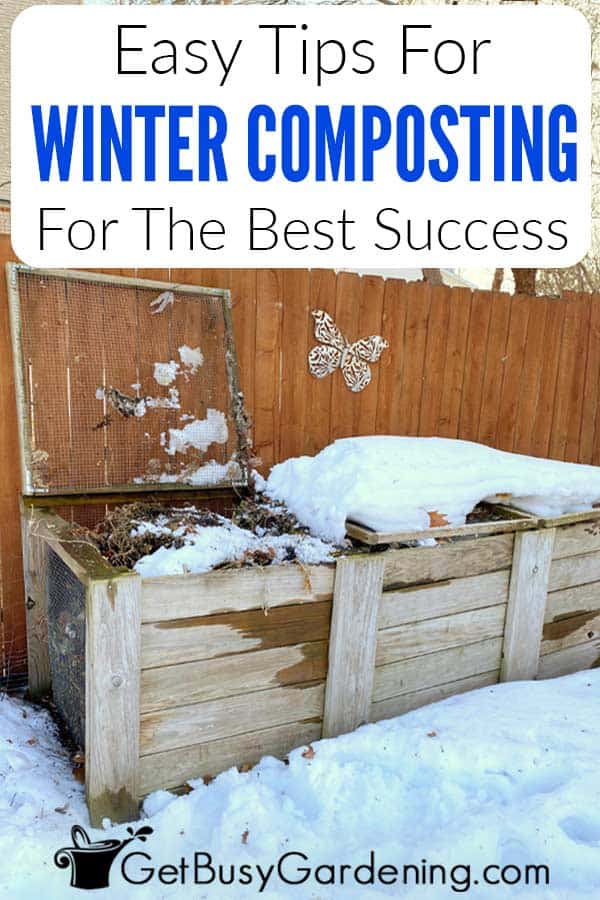


Michael Moore says
Our compost bin is only the size of one of your compartments, but we haven’t managed to overflow it yet. I just keep using it as fast as it’s ready!
Even though we don’t have a yard waste bin, it has saved us money though, we keep putting off getting a garbage disposal since we use most of what would go down the drain anyways.
Amy Andrychowicz says
Thanks! I use compost as fast as it’s ready too, or at least I try to. I hope that by rotating my bins, I’ll have larger amounts of compost to use in the fall and spring. I hear you about the yard waste disposal. We hardly ever use our bin either.